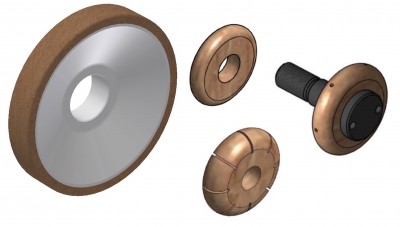
Meister Abrasives says its new HPL (High Performance Lubrication) grinding wheels rely on premium-grade CBN crystals fixed with durable, porous, intrinsically lubricated bonding matrix to allow substantially faster grinding of difficult materials without sacrificing quality due to wheel loading and/or part burning.
According to Dr. Peter Beyer, PhD, CEO and chief technologist for Meister Abrasives, the new HPL superabrasive wheels are a significant extension of the company’s proprietary HPB (High Performance Bonding Technology). It departs from conventional approaches to manufacturing wheels with lubricating properties that rely on fillers that can clog the wheel’s pores and are less likely to distribute lubricating properties evenly.
Meister HPL wheels contain a lubricant that is intrinsic to the bonding matrix chemistry and is released uniformly as the wheel breaks down. Wheels manufactured with this technology minimize friction from bond/workpiece interactions, minimize heat generation and deter the onset of metal loading into the bond structure.
HPL technology also makes it possible to implement wheel characteristics that are not economically feasible with standard vitrified bondings. The enhanced grit retention and lubricating properties of the bond make it possible to utilize high concentrations of premium-grade CBN crystals that in a standard bonding matrix would generate too much pressure and heat.
The unique properties of these intrinsically lubricated wheels address a wide range of problems including: burning of parts, wheel loading, excessive wheel wear due to heat related issues, and quality issues due to temperature sensitive materials.
Dr. Beyer indicated that R&D for this technology has been going on for about 18 months. He said, “Early adapters in Europe and the United States have tested dozens of application-specific HPL recipes with excellent results. Although the extent of performance improvements varies from application to application, I can say that our customers rarely switch to a new technology for existing production grinding applications if they are not realizing a 25 percent or better improvement in productivity.”
According to Bruce Northrup, vice president and general manager of Meister Abrasives USA, applications for the new HPL abrasive technology include:
- Deep bore grinding with limited coolant access, such as fuel injection nozzle components.
- Blind-end bore grinding such as lash adjusters and tappets.
- Heavy-stock form grinding applications such as electronic power steering (EPS) ball-nut tracks.
- Creep-feed grinding of tool steels and superalloys.
- High stock removal out-of-round grinding for punches.
- Any application where the concentration of oil and lubricant are less than ideal or the flow of the coolant is impeded, as is the case with deep bores.
HPL (High Performance Lubrication) CBN grinding wheels are available for both internal and external grinding with mesh sizes ranging from 60 to 1200.
Contact Details
Related Glossary Terms
- abrasive
abrasive
Substance used for grinding, honing, lapping, superfinishing and polishing. Examples include garnet, emery, corundum, silicon carbide, cubic boron nitride and diamond in various grit sizes.
- burning
burning
Rotary tool that removes hard or soft materials similar to a rotary file. A bur’s teeth, or flutes, have a negative rake.
- coolant
coolant
Fluid that reduces temperature buildup at the tool/workpiece interface during machining. Normally takes the form of a liquid such as soluble or chemical mixtures (semisynthetic, synthetic) but can be pressurized air or other gas. Because of water’s ability to absorb great quantities of heat, it is widely used as a coolant and vehicle for various cutting compounds, with the water-to-compound ratio varying with the machining task. See cutting fluid; semisynthetic cutting fluid; soluble-oil cutting fluid; synthetic cutting fluid.
- creep-feed grinding
creep-feed grinding
Grinding operation in which the grinding wheel is slowly fed into the workpiece at sufficient depth of cut to accomplish in one pass what otherwise would require repeated passes. See grinding.
- cubic boron nitride ( CBN)
cubic boron nitride ( CBN)
Crystal manufactured from boron nitride under high pressure and temperature. Used to cut hard-to-machine ferrous and nickel-base materials up to 70 HRC. Second hardest material after diamond. See superabrasive tools.
- grinding
grinding
Machining operation in which material is removed from the workpiece by a powered abrasive wheel, stone, belt, paste, sheet, compound, slurry, etc. Takes various forms: surface grinding (creates flat and/or squared surfaces); cylindrical grinding (for external cylindrical and tapered shapes, fillets, undercuts, etc.); centerless grinding; chamfering; thread and form grinding; tool and cutter grinding; offhand grinding; lapping and polishing (grinding with extremely fine grits to create ultrasmooth surfaces); honing; and disc grinding.
- superalloys
superalloys
Tough, difficult-to-machine alloys; includes Hastelloy, Inconel and Monel. Many are nickel-base metals.
- tool steels
tool steels
Group of alloy steels which, after proper heat treatment, provide the combination of properties required for cutting tool and die applications. The American Iron and Steel Institute divides tool steels into six major categories: water hardening, shock resisting, cold work, hot work, special purpose and high speed.






